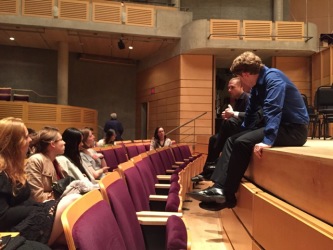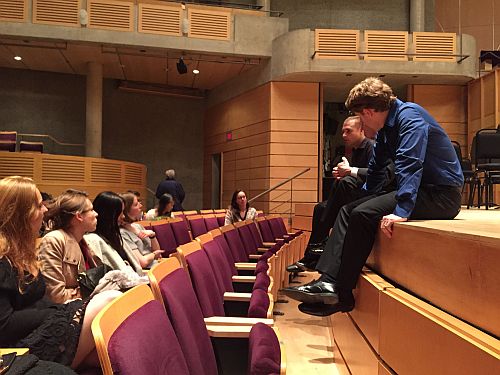 Canada Ligeti, Chopin and Brahms: Adam Golka (piano), Vancouver Symphony Orchestra, Joshua Weilerstein (conductor), Chan Centre, Vancouver, BC, 17.10.2014.(GN)
Canada Ligeti, Chopin and Brahms: Adam Golka (piano), Vancouver Symphony Orchestra, Joshua Weilerstein (conductor), Chan Centre, Vancouver, BC, 17.10.2014.(GN)
Ligeti: Romanian Concerto (1951)
Chopin: Piano Concerto No. 2 in F minor, Op. 21
Brahms: Symphony No. 4 in E minor, Op. 98
For the past few seasons, the Vancouver Symphony Orchestra has given one subscription series at the state-of-the-art Chan Shun Concert Hall at the University of British Columbia. While this would seemingly give UBC students a rare opportunity to see world-class performers right in their own backyard, this has not really happened. Nonetheless, with young and talented 26-year-old pianist Adam Golka appearing at this concert with up-and-coming 27-year-old Assistant Conductor of the New York Philharmonic, Joshua Weilerstein, I thought that this was the perfect setting to let youth meet youth. I have learned the hard way that simply telling undergraduate students that they should see a concert is no guarantee of attendance. So, this time, I actually went out and bought around 60 tickets and sold them to my students at a very modest cost right in class. I also arranged with very cooperative symphony officials for both young artists to come back on stage after the concert (accompanied by VSO concertmaster Dale Barltrop) and informally field questions and the like from the students.

Well, each and every student showed up, and a good number came to the after-talk. The three musicians were absolutely remarkable in conversing with the students and, above all, in communicating their love of classical music. Given our never-ending concern with ‘youth’ these days, I found this a most uplifting experience. And as far as I have checked, so did the students. It was an essential bonus that both Golka and Weilerstein were on fine form during the concert, too.
Adam Golka is a very promising American pianist, and the sharp, life-giving way he attacks the keyboard certainly throws me back to the technique and sound of his teacher, Leon Fleisher. He was the winner of the 2008 Gilmore Young Artist Award and the 2009 Max I. Allen Classical Fellowship Award of the American Pianists Association. While Golka has spent considerable time on Beethoven and Brahms, his move to Chopin’s Piano Concerto No. 2 at this concert was, on balance, very successful. His interpretation was understandably a more firm, classical reading, beautifully poised and tightly-knit, but still exhibiting bravura and sentiment. His collaboration with Weilerstein in the first movement was almost perfect, the conductor bringing great shape and élan to the orchestral tuttis and being in step with the soloist at every turn. The second movement was also beautifully turned and deeply felt, just falling short of the last degree of fantasy. And the sometimes-dogged finale was also brought home quite successfully, albeit with a hint of caution. A fairly deliberate tempo was set and here I did feel that there might have been more sparkle and push. Overall, this was a different Chopin, sharper and less flowing, always emphasizing the dramatic contrasts in the writing, but full of insight and youthful energy. The pianism itself was superb: I shall not soon forget Golka’s crisp articulation or his powerful and sharply-etched trills.
Given that his father, Don Weilerstein, was a founding member of the Cleveland Quartet and his sister Alisa is now a celebrated young cellist, there would seem to be little reason why conductor/violinist Joshua Weilerstein should not turn out to be a very fine musician too. And so it proved in his conducting of Brahms’ Fourth Symphony. For a maestro so young, what impressed me was his patience and sensitivity in bringing out the beauty and power of this work. He never resorted to display or brilliance to be convincing; everything was intelligently and methodically drawn, building considerable power and electricity at climaxes.
One complication in judging this performance nonetheless was the venue itself. Seating about 1300, the Chan Centre is pretty well ideal for a classical-sized orchestra but really too small for a full romantic one. The Brahms is about the largest work I have seen undertaken by the VSO here. The reverberation in the Chan is typically controlled by long curtains that can be rolled up or down over exposed concrete or glass. For this performance, the decision was to pull the curtains all the way down and, from the first timpani tap, I could tell that decay time was extremely short. The net result was a sound that, while appealingly warm, had less cutting edge or expansion than one might be used to, and a bottom end was somewhat opaque and blowsy—especially at high volumes. These issues concerned me as I tried to evaluate this performance.
I thought Weilerstein’s first movement seemed quite lovely, achieving strong dramatic weight, telling repose and a long lyrical line. One noticed how the conductor always got the violins and cellos to push out their phrases expressively while still maintaining overall cohesion and line. It was perhaps only in the quieter passages before we moved to the coda that I felt any loss of concentration. Indeed, the warmth, sensitivity and patience in articulation, reminded me to some extent of the classic performances of Bruno Walter or Carlo Maria Guilini. But how warm was it supposed to be? When I asked the conductor whether either of these great interpreters were his model, he said that it was probably Carlos Kleiber that he held most dear, and we all know that Kleiber was much leaner than many in this work. So, while I liked this interpretation a great deal, just how much of my perception of its warmth was created by the Chan’s acoustics? I find this disturbing.
The remainder of the symphony built well upon the opening. While the horn theme at the beginning of the Andante did not project as luminously as it might, the movement progressed intelligently and found considerable depth. Here, and at some points in the last movement, there were times where the conductor was slightly over-conscientious, dwelling on details and the music’s beauty a little too lovingly, and impeding progress a little. But this is sort of thing that one might expect from a sensitive young conductor who tries to get everything perfect. Similarly, the expansion of the glowing lower strings at the end of the movement struck me as too full, having an almost Brucknerian amplitude. The Scherzo had an appealing athleticism, but consistency might have suggested more weight and dramatic punctuation rather than motion. But, all told, when the work came to its final declaration, it did feel like we had been on a truly epic journey, and that is the important thing. The conductor’s control is admirable.
Weilerstein warmed up with some uncharacteristic early Ligeti, his Romanian Concerto (1951), written when he was a professor at Budapest Conservatory and revised in the 1990’s. This was an interesting way to start a concert because this work has only received consistent attention following the composer’s death in 2006. Rustic Romanian rhythms, ‘authentic’ instrumental effects, frenzied gypsy violin solos and a number of false endings are all there—engaging in some way but slight in another. One can easily find allusions to Enescu but the major link is to Bartok’s Dance Suite and his ‘night music’. The conductor found a strong atmosphere and a good snap in the rhythms, and Dale Barltrop was quite superb in the violin solos.
THE POST-CONCERT DISCUSSION
This discussion had the feeling of an informal chit-chat: Dale Barltrop, Adam Golka and Joshua Weilerstein sat on the edge of the stage, the students just below. Dale opened by discussing what a concertmaster does (see my interview with him, elsewhere on this site). A student then asked Adam how he became a concert pianist. He explained that he came from a musical background and started piano when he was very young, but jokingly suggested that what has kept him going for all these years is “pure insanity.” Another student asked whether the artists felt nervous when they came on stage for a performance. Joshua said that he feels nervous if he has to speak to the full audience but is quite comfortable if he just has to face the orchestra. Adam said that he feels a range of emotions at first, but after he sits down at the keyboard, it’s he and the piano.
When asked about performance mistakes, all agreed that there are errors everywhere, and correcting them is simply part of the job. Dale was emphatic that music-making is a human—not a machine-like—activity, and humans make mistakes. All the artists were also emphatic that they were not doing this for the money; it was their love of great music and their joy in performing that carried them forward. When the discussion turned to what training was needed to become a conductor, Joshua made it clear that his principal instrument was the violin, but that knowing how to play the piano is an invaluable resource. He also admitted that he still felt some tug-of-war between being a conductor and performing as a violin soloist, but then explained why he was no longer attracted to the life of an international violinist. The reason: the recent United States ban on elephant-tusk ivory exports now means that classic ivory-tipped violin bows can be seized and destroyed by customs officials if one attempts to travel abroad.
It was then Joshua’s turn to ask the students some questions. (His website notes his enthusiasm for working with younger listeners.) When the students were asked if it was helpful to have the conductor explain the work before it was played, all responded ‘yes’. When asked whether they would really enjoy another concert experience like this, they all agreed unanimously. While a number of attendees were music students, the fact that many other general arts undergraduates—with limited familiarity with classical music—were so enthusiastic was particularly telling. I thought it was quite touching how these three artists interacted with the students with complete sincerity, and more and more questions seemed to emerge as the discussion proceeded.
Geoffrey Newman
Previously published in a slightly different form on http://www.vanclassicalmusic.com
